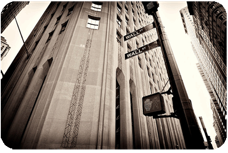 When the stock market collapsed in 2008, the government deemed Wall Street’s ailing banks “too big to fail” and provided them with a multi-billion dollar bailout. The emergency loan ultimately saved the banks, but has provided no shortage of controversy ever since. To the financial sector’s critics, many of the problems caused by these banks stemmed from their enormous size. In fact, nothing much has changed since the financial collapse: the same five banks that dominated bond underwriting and currency trading in 2007 continued to rule the market in 2014.
When the stock market collapsed in 2008, the government deemed Wall Street’s ailing banks “too big to fail” and provided them with a multi-billion dollar bailout. The emergency loan ultimately saved the banks, but has provided no shortage of controversy ever since. To the financial sector’s critics, many of the problems caused by these banks stemmed from their enormous size. In fact, nothing much has changed since the financial collapse: the same five banks that dominated bond underwriting and currency trading in 2007 continued to rule the market in 2014.
For the most part, the Dodd-Frank Wall Street Reform Act of 2010 has failed to change the ways big banks do business. However, some recent regulations could finally force a few of these institutions to shrink. At the end of last year, Federal Reserve chief Janet Yellen announced the Fed would be increasing the amount of capital that large banks need to have on hand in case of emergencies. This increased reserve requirement would allow financial institutions to provide their own bailout if they default. What’s more, with less cash on hand banks will hopefully become more discouraged from spending money on risky assets and liabilities.
Of course, big banks can avoid all these obstacles if they’re willing to slim down. Small financial institutions don’t need to hold as much cash on hand, leaving them free to lend how they please. As a result, many banks are already devising ways to cut back. Britain’s HSCBC says its considering “extreme measures” for some departments while Citigroup has shrunk staff by nearly a third as it exits several areas of business. Still, just because banks are getting smaller doesn’t mean they’re necessarily becoming safer. After all, Lehman Brothers triggered the financial meltdown and at the time it was only the sector’s fourth largest investment bank. Today’s biggest firms would have to shrink considerably to approach even Lehman’s dimensions, suggesting that size isn’t the sole source of Wall Street’s problems.
Questions:
- What does increasing the reserve requirement mean?
- Are consumer deposits safe if a bank fails due to poor practices?
Source: Peter Coy, “Should the Banks Be Cut Down to Size?” Bloomberg BusinessWeek, March 30, 2015. Photo by: Emmanuel Huybrechts.
